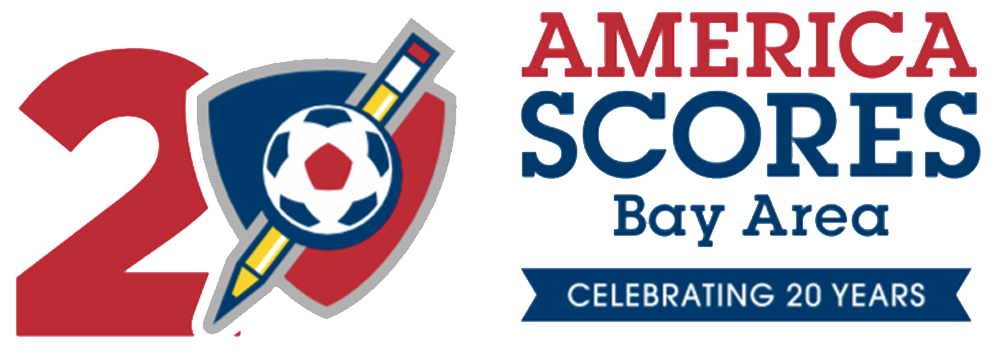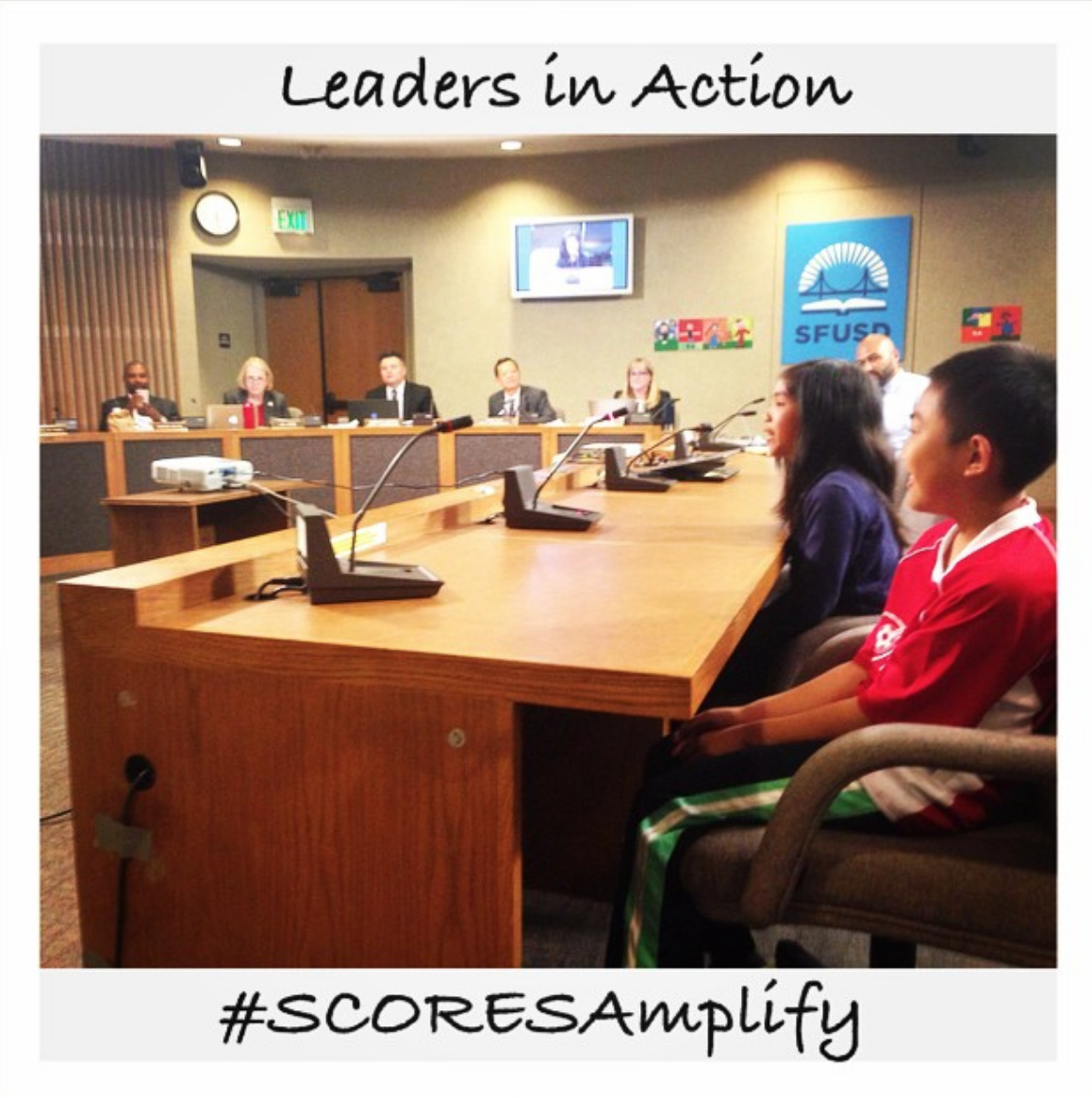Civic Engagement at America SCORES
Third graders Seville Ramos and Briana Aleman from Garfield Elementary School
“Homeless people need socks.” It’s the kind of thing you realize seeing people sleeping on park benches with bare feet exposed.
Seville Ramos and Briana Aleman are third graders at Garfield Elementary in the iconic North Beach district in San Francisco. Coit Tower graces their district, and two blocks from Garfield Elementary is one of the oldest city parks in San Francisco. Framed by sidewalk cafes and restaurants, the verdant square is home to the architecturally dramatic Saints Peter and Paul Church and to the cast-iron Benjamin Franklin statue, the oldest standing monument in San Francisco. People picnic, listen to music, and sit on park benches here. Washington Square Park is a clear community center, and included in that community are the chronically homeless.
Seville and Aleman are part of the America SCORES program at Garfield Elementary. With their SCORES team they play soccer, write poetry, and engage in service learning. America SCORES’ third component - civic engagement through service learning - is a critical glue, fusing together and buttressing the team-building, self-awareness, and creative expression inherent in the soccer and poetry programming. At the heart of service learning is figuring out who you are, how you fit within a larger community, and what you can do to make your community better for everyone.
And that’s how Seville, Briana, and their classmates came to create wellness hygiene kits for the chronically homeless population living two blocks from their school in Washington Square Park. The students collected socks, toiletries, and other basic necessities for their homeless neighbors. They sought out information from local groups helping the homeless, researched online, and secured permission from the San Francisco Recreation and Park Department to leave the hygiene kits under the sinks in public park bathrooms.
Jennifer Yang is a Garfield Elementary SCORES instructor. “Around our neighborhood and even taking the bus, we see a lot of different kinds of people. It’s up to us as educators to show our students that there are a lot of different kinds of people here, and we owe it to them to listen to their stories and to think about how we can help them.”
Part of that meant looking toward social media for greater understanding, especially Instagram. The Garfield students followed the personal stories of the homeless on the Instagram handles @sfhumans and @homelessdailysf, both of which capture the humanity of the homeless.
To understand service learning at America SCORES is to realize that the Garfield Elementary project is only one of many. SCORES students have created an array of service learning projects to better the lives of those around them in the Bay Area. One team assembled contributions of seeds, flowers, and small trees from parents and neighbors to plant a big bare corner of dirt in their school playground. Other teams addressed bullying head-on; visited and read to seniors at local senior centers; informed their peers about gun control; ran food drives for the San Francisco Food Bank; used poetry as a vehicle to warn of the dangers of drug abuse; and educated peers about the dangers of exposure to toxic chemicals. One SCORES team even addressed the San Francisco Board of Education. All of these projects were conceived of and developed by the students themselves.
Service learning is at the heart of 21st-century education. It’s experiential, interactive, reflective, and involves critical thinking. It heightens both self-awareness and the understanding of one’s place within a larger community, all while building a sense of ownership and responsibility. It empowers students. It sows the seed for lifelong civic engagement and a sense of purpose, both of which are tied to a meaningful, connected life and to greater happiness. And service learning can be fun, particularly when experienced as a cohesive group.
Colin Schmidt, SCORES CEO explains: "These projects are at the heart of SCORES. Students learn that they can give back and be part of the solution for problems in their own communities. Through a season-long exploration, SCORES teams collaborate to examine their school and neighborhood communities, engaging in a deliberate five-step process incorporating close observation, investigation, and research. After taking action, the students reflect on their learnings and share those findings with the larger community."
Last week, SCORES students shared their projects in the Civic Center. With the wind blowing briskly, students from Garfield, John Muir, Moscone, and Tenderloin Community schools and from the Salvation Army Kroc Center presented their discoveries to each other and to the local tech community. A group of employees from Twitter were out for a day of service too, learning more about their community, just like the SCORES students. After the presentations, everyone played soccer, naturally!
The students all take part in the SCORES Civic Center league. Their soccer practice and games happen smack in the center of the city, on a field bordered by the Tenderloin and set against prominent city landmarks: City Hall, the War Memorial Opera House, and the Asian Art Museum. Here culture, demographics, and strife all intersect.
Caroline Balerim is Head of Community Outreach and Philanthropy at Twitter. “We talk about the invisible line on Market Street: those North of Market Street and those South of Market Street. I think everyone is in their own world, for better or for worse. There’s an opportunity here to be curious about and find out what and who is on the other side,” she explains. And an experience of connection can have lasting effects. “Every interaction is an opportunity to grow the tapestry and make society stronger. So if you have connections with people and with place, it can make you want to navigate and support that place.”
That resonates with Cait Steiner, Executive Director of the foundation Trevor TCR, which funds nonprofits focused on the health, education, and wellbeing. SCORES, she points out, hits all three targets. Funding America SCORES was an obvious yes. Steiner calls SCORES service learning cutting edge. “It’s such an innovative component. There’s always learning happening through the process, and it can spark something really intense in you in wanting to make a difference.”
Check out the array of projects below. America SCORES students making the world around them a better place.
Sanchez Elementary students raise awareness on bullying and its effects on the community.
Lakeshore Elementary students warn of the dangers of exposure to toxic chemicals
Students from ER Taylor and Garfield Elementary schools address the San Francisco Board of Education.
The Tenderloin Recreation Center team with Coach Marquis and SCORES CEO Colin Schmidt sell lemonade at game day to raise money for Glide Memorial Church.
Hillcrest Elementary students show us the changing times in San Francisco and what it’s like to live here.
“It was really amazing to see the kids present some of their service-learning projects centered around food insecurity, mental health, and taking care of our environment.”
Twitter employees spending time with America SCORES students
Moscone Elementary students spend time with senior citizens reading and playing games together and discussing the similarities and differences between their generations.
Moscone Elementary school students use poetry as a means to teach others about the dangers of drug use.
Garfield Elementary School Service Learning










